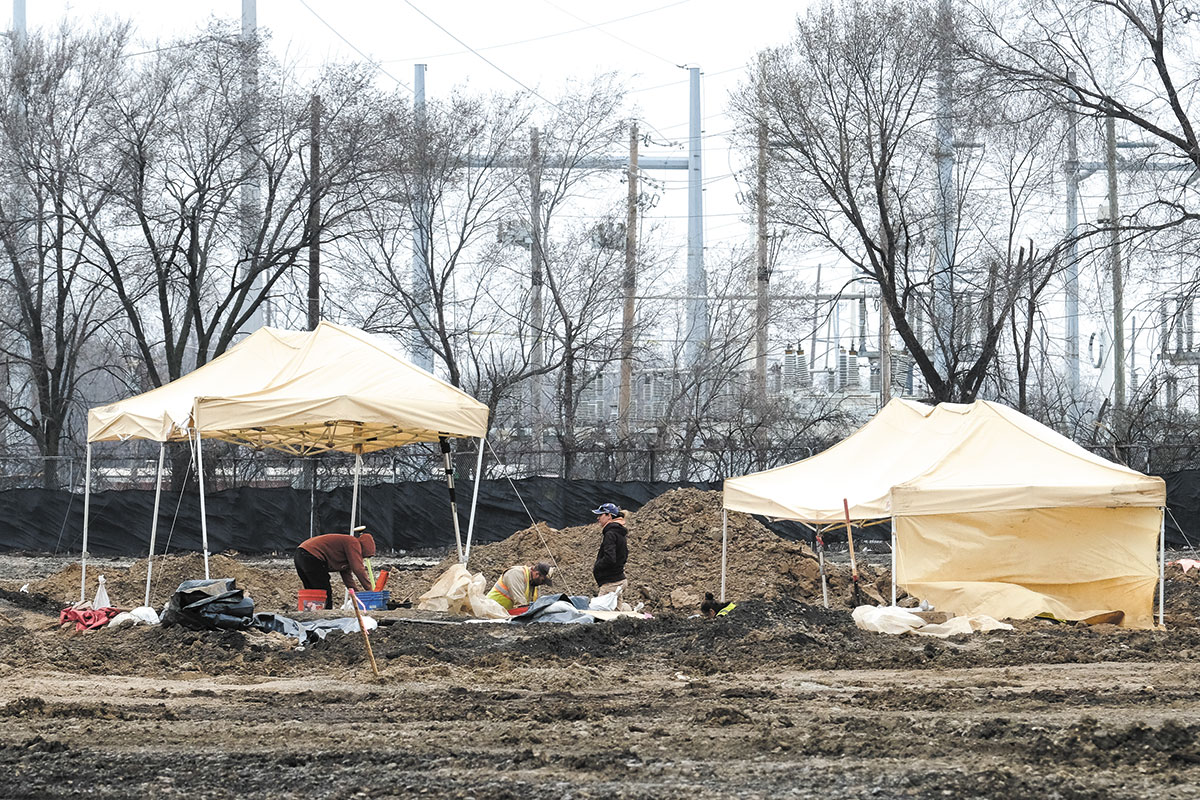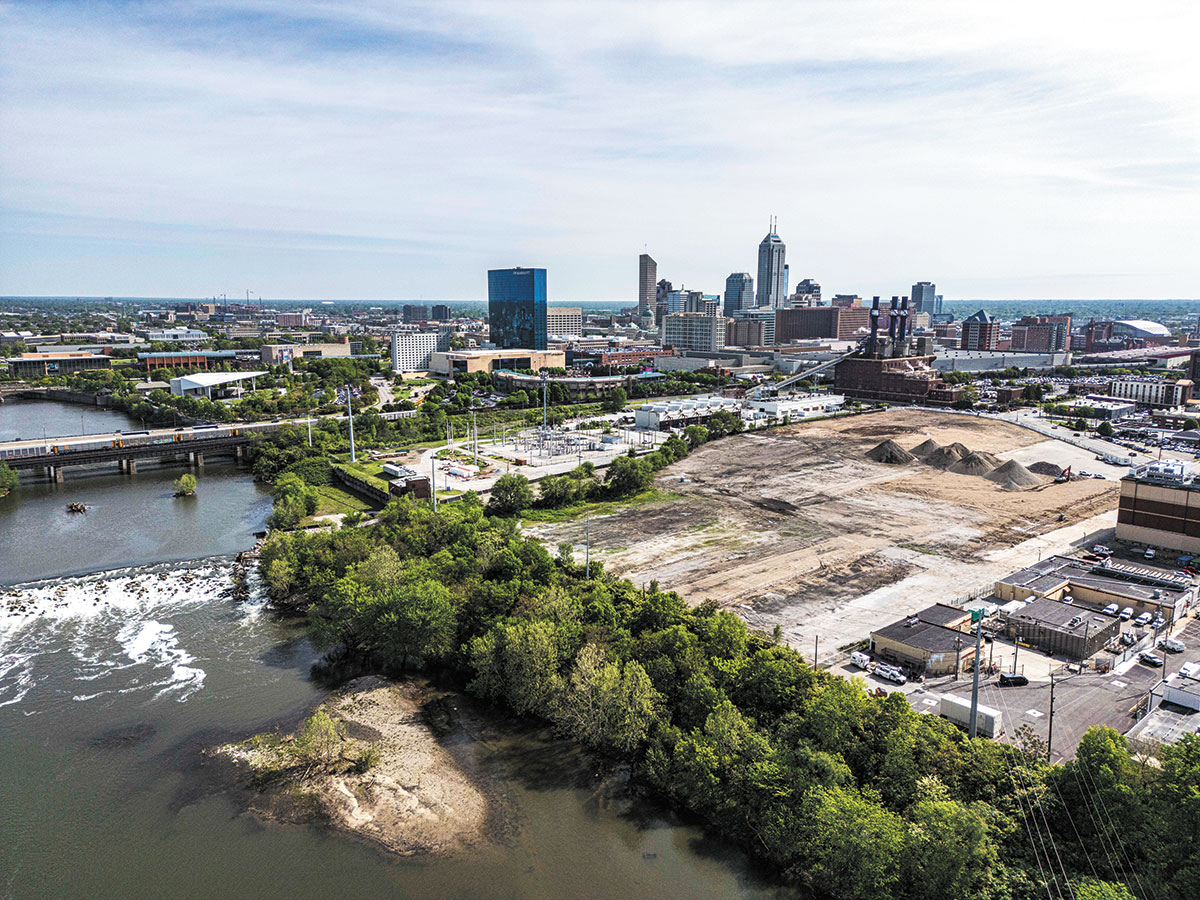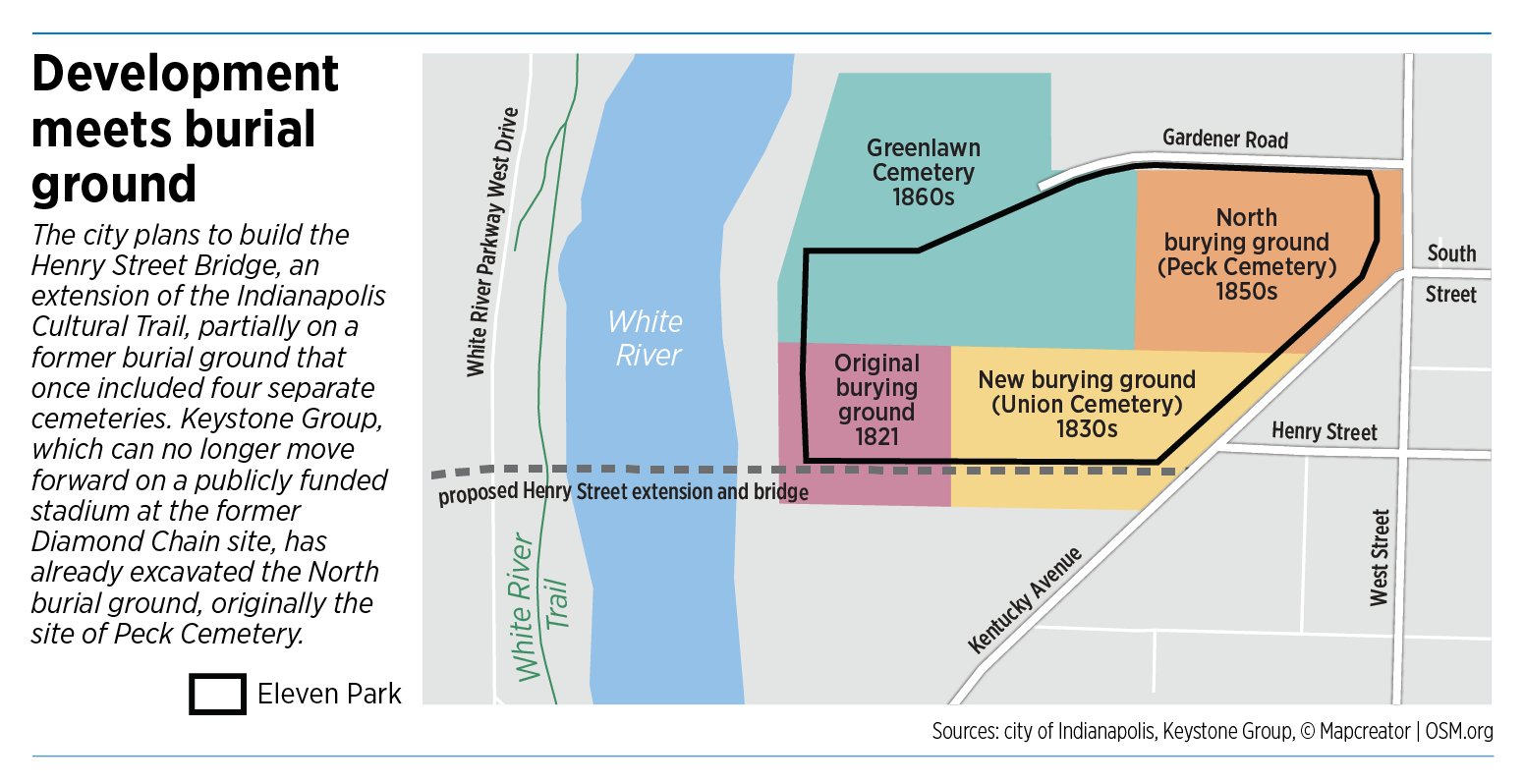Subscriber Benefit
As a subscriber you can listen to articles at work, in the car, or while you work out. Subscribe Now
With its plans to build a stadium district along the White River now scuttled, Indianapolis-based Keystone Group is beginning to assess what’s next for the downtown Diamond Chain parcel it bought for $7.3 million in 2021 and on which it says it has already spent tens of millions of dollars more.
But finding a path forward for the 20-acre site will not be easy.
Not only did the Hogsett administration withdraw from negotiations with Keystone to build a stadium on the site and incentivize a larger mixed-use development there. But now it says no development can proceed on the property unless Keystone—or a future owner—agrees to treat human remains found there in a way that is consistent with the wishes of a community group, which could cost millions of dollars per acre to implement.
Four early cemeteries were located on what would become the Diamond Chain industrial site. Records show some of the remains were moved to make way for past developments. But historians believe the remains of many of the city’s earliest Black residents were never moved and remain buried at the site.
Keystone officials say they are following state law in the excavation and reinterment of the remains it finds, but city officials now say that’s not good enough and that more must be done to memorialize and research those buried on the “sacred ground.” They project Keystone or a future property owner could have to spend as much as $12 million per acre if they want to prepare the site for development.

Keystone owner Ersal Ozdemir has been tightlipped about how he plans to proceed.
But the city’s requirements will likely act as “stop sticks” for future development on the property, said Abbe Hohmann, the president of Indianapolis-based Site Strategies Advisory LLC, which specializes in site evaluation, parcel assembly and redevelopment efforts.
Hohmann isn’t involved in proposed projects at the site or the city’s plans to build a bridge on a 1-acre adjacent parcel it owns. But she said the Hogsett administration’s move to impose additional requirements on the property before it can be developed will not only make it tough for Keystone to move forward but will deter other companies from buying the property.
That makes the city the “best, and possibly only buyer” of the Diamond Chain site, she said.

On May 22, Chief Deputy Mayor Dan Parker sent a letter to Ozdemir offering to buy the Diamond Chain property for a price that would be based on two independent appraisals. And Mayor Joe Hogsett said that a park or memorial could be the best use of the property, given the information that historians have uncovered about who and how many people could be buried there.
But experts told IBJ those appraisals—and the resulting price the city could pay—will be affected by the requirements the Hogsett administration has now put in place for the site’s development.
“It reduces its value, because as this carries forward it’s going to impact the usability of the site,” said Doug Morris McCoy, a professor and the Al and Shary Oak director of real estate at Indiana University. “It’s an issue for whoever wants to develop that site, in that they’ll have the same problem as Keystone.”
He compared the fiscal magnitude of the city’s new requirements for handling the remains to the discovery of a costly environmental problem on a piece of property. McCoy said a developer would be unlikely to ever recover the costs of the mitigation, which means the value of the property drops.

Keystone officials haven’t said whether they are considering the city’s offer, which they call “a last-ditch effort to salvage the bungled rollout of a half-baked idea.”
But Keystone has said it spent or committed to spending $26 million to demolish the Diamond Chain factory and do architecture and engineering work for Eleven Park. Those are costs that wouldn’t likely be recouped by a purchase price based on appraisals.
Keystone bought the Diamond Chain site in 2021 for the sole purpose of building Eleven Park, a proposed mixed-use housing and entertainment district. The development—which Ozdemir had projected would become a $1.5 billion investment—was to be anchored by a stadium for the Indy Eleven, a soccer team he founded that plays in a middle-tier professional league. Keystone had also planned 200,000 square feet of office space, extensive retail and restaurant offerings, a hotel and an indoor music venue for the site.
To fund the stadium, which was to be owned by the city’s Capital Improvement Board, Ozdemir persuaded Indiana lawmakers to pass legislation that authorized the city to redirect some tax money collected from the district and other nearby development to pay off construction bonds. He was also pursuing city incentives for other parts of the district’s construction.
But earlier this year, the Hosgett administration walked away from those negotiations. Officials said later that the financing for the deal didn’t add up and wouldn’t have been a smart move for taxpayers.
Instead, Hogsett is now seeking to build a stadium on the east side of downtown—on and around the site of the Indianapolis Downtown Heliport—as part of an effort to attract a Major League Soccer team. Hogsett visited MLS officials in April and has been talking for months with a longtime soccer executive who says he has owners interested in pursuing an MLS club if the city can build the stadium.
That has left Keystone without the anchor for its district and no incentives to build any part of the mixed-use development.

“They have a decent challenge in front of them,” Chris Reckley, director of acquisitions for Michigan-based Dietz Property Group, said of Keystone’s predicament. “They had a lot of things going for the site that together make a lot of sense, but those [elements] are very difficult to parcel up and sell.”
That’s only complicated by the city’s new policies related to the Diamond Chain site.
“Knowing what we know now, any proposed future development ought to follow a painstaking and inclusive community conversation on the different perspectives about how to respect the history of the site and the individuals still laid to rest there,” Parker said in his letter to Keystone.
“Any future development plans entertained by the city on this site should follow these community conversations, a call we are hearing from community groups and councilors alike. The city well recognizes your investment on this important and historic site and proposes an additional way forward—an offer that we hope can fairly compensate Keystone for its efforts.”
The city previously acquired a 1-acre parcel from Keystone along the southern border of the Diamond Chain site so it could build a vehicle and pedestrian bridge over the White River. The bridge is part of a promise the city made during negotiations with Elanco Animal Health, which is building a headquarters campus on the west side of the river at the former GM stamping plant.
City officials say its research indicates there could be the remains of some 650 people buried under that 1-acre parcel, and it expects to spend up to $12 million to excavate, reinter and memorialize those remains in a way that a community group suggests. Construction on the bridge has not started.
Keystone’s site is nearly 20 times larger than the city’s parcel. It has not done a comprehensive review of what remains could be found across its entire property, but it has encountered remains in the demolition and site-preparation work that has been underway for months.
Keystone said it planned to spend less than $1 million to excavate five acres on the northeast portion of the property and reinter those remains. It is waiting for the Indiana Department of Natural Resources to approve its plans for reinterment.
But those plans won’t be enough to meet the city’s expectations.
Alexandra Miller, a spokesperson for Keystone, did not answer numerous emailed questions related to Keystone’s path forward, including whether Ozdemir is open to selling the property, whether the private elements of Eleven Park could move forward without a stadium, if a portion of the site could be converted to a public amenity and what Keystone’s own financial assessment is for the Diamond Chain property.
Rather, she sent an emailed statement saying the city’s actions were detrimental to Keystone’s efforts to redevelop the site.
“Keystone Group dedicated over six years and spent tens of millions of dollars acquiring, titling, and preparing this critical downtown site for redevelopment. City leadership was an active participant and enthusiastic partner in these efforts and made various commitments to Keystone, local and state officials, the westside and surrounding neighborhoods, and the business community,” said Miller, senior director of communications and public relations for the company.
“Although Keystone had secured private financing and investment for Eleven Park, the city’s jarring decision to abandon these commitments, along with their recent media communications, has threatened the future of this site and downtown development as a whole.”

No comment
To try to assess the impact of the city’s requirements for the Diamond Chain site, IBJ contacted principals of seven central Indiana development firms for this story. Two of them did not respond, and the other five refused to discuss the project, with one calling the situation “toxic.”
Some said privately they did not want to opine on the situation because they either have business with the city or are interested in future projects.
Several land use attorneys and brokers contacted by IBJ also declined to comment, either claiming conflict of interest or a desire to abstain due to the volatile nature of the situation.
But IU’s McCoy said any increase in the cost of a development makes a project more challenging—especially if spending the money doesn’t result in an increase in the project’s value.
McCoy said that if Keystone decided to sell the property now, it would likely be at a substantial loss.
The city could offer Keystone a price that is higher than any appraisals it receives. That’s what the city did when it acquired the downtown Pan Am Plaza property from Indianapolis-based Kite Realty Group in 2023. The Hogsett administration paid $54.3 million, a figure roughly 83% higher than the average appraised value of about $29.6 million.
Parker said the situations are different, however, because the sum paid for the plaza was for “a lot more than just the land” on which an expansion of the Indiana Convention Center and new 800-room hotel are being built.
“We bought the design. We bought the contract with Hilton. So there were a lot of things in that,” he said.
In this case, the city would likely plan not to redevelop the property but to use it for a park or green space.
“The letter the mayor authorized us to send to Keystone Group laid out our vision for how to move forward on Diamond Chain, including the offer. Keystone owns the property and they would have to engage with us in terms of a discussion related to the fair market value, [but] we’ve not heard anything related to that. The city can’t just take the property. … There would have to be a negotiation over the offer,” he said.
The city did not respond to multiple questions related to more details about what it would do with property.

Stephen Alexander, a project architect and principal with Prince Alexander Architecture who has been outspoken about development on the south side of downtown, said the city’s moves are taking the “momentum out of a major riverfront project.”
Alexander said one solution could be selling a portion of the Diamond Chain property—about 10 acres closest to the White River—to the city for conversion into a public amenity, while Keystone or another developer could continue private development on the remaining acreage.
“Those two things are not mutually exclusive,” Alexander said. “If you drew a line around the 5 acres, or however much is the most impacted by human remains and made that a memorial, then made the rest into a fairly high density [project], Ozdemir is still going to capture all of that.”
While it is unknown how many total burials are scattered across the Diamond Chain site, the eastern portions of the property are generally thought to be less dense with graves because that is where Diamond Chain and other development has previously been done, with thousands of remains moved for those projects in the early 20th century.
Also, when Elanco announced in 2020 that it would move to the GM site on the west side of the river, the state’s site plans and renderings contemplated greenspace on at least part of the Diamond Chain property. Leaders of White River State Park did not return a call requesting comment on whether the park—which is state owned—would be interested in expanding to all or a portion of the Diamond Chain site.

Mike Horrigan, president of the Horrigan Land Group division of Indianapolis-based Bradley Co., said there should be a way for the city or state to turn part of the site into green space and still do development on the east side of the property, along West Street.
“What it really comes down to is what the partnership agreement would look like,” he said. “It’s a dollars and cents equation to see if and how you can make it work.”
Few other options
Hohmann, the real estate adviser, said that Ozdemir may seek a path involving litigation—a move that would be reminiscent of what occurred when the city sought to buy the GM stamping plant site from Ambrose Property Group in 2019, at the time threatening eminent domain if the company didn’t sell.
“If Ersal feels that the city’s change has damaged him, and he has some legal path to maybe suing the city … then that would motivate the city to make an offer and buy it to avoid that litigation,” she said. “But if [he] doesn’t really have any legal path to push back on the city, then maybe he would take an offer as a last resort and try to negotiate as much as he can to recoup his out of pocket.”
Keystone officials did not say whether they are considering legal action against the city.
The Hogsett administration hasn’t met with Keystone officials since April 12, when Parker and city attorney Scott Chinn, a partner at Faegre Drinker, informed the company Hogsett was fully walking away from negotiations on Eleven Park in favor of an alternative.
Still, Reckley, the Dietz executive, said he is optimistic the property will see development of some kind in the coming years and likely on a tighter timeline than what has occurred with the stamping plant property across the river.
“Because this is closer to downtown, I think there’s more motivation for a lot of people to make this one work and faster than the GM site,” he said. “I think it’s in a lot more people’s interest to make this one function.”•
Please enable JavaScript to view this content.


I am positive the city actually doesn’t care about this considering 2 different buildings were constructed on this site before. They are pandering at this point. The mayor knew all about this and was happy as a drunk clam when he was at the groundbreaking.
The State laws that make archeological sites very difficult to develop were not in place until 1979. Those buildings had already been constructed.
diamond chain had been there for a hundred years. who are they pandering to? respect for human remains is just nothing huh? ozdemir didn’t have his ducks in a row.
The Trouble remains, if the city and the state knew these cemeteries were there, why and how were construction permits issued for demolition and preliminary site work? Seems there was much more at fault than Keystone.?
The memorial green space on the river with Big Development on the east portion sounds great. Get it All done. Nothing stopping you.
Hogsett’s administration totally blew up this private developer’s investment. Keystone should get this case in front of a jury and watch the cash rain! No way does a jury see this as anything other than negligent interference by a bought off administration. The city showed up at the ground breaking ceremony for crying out loud! Common juror will see the perspective economic relationship which the city was on board with until they were not.
The private developer also didn’t show up with the private funding until way too late (and I have doubts that was anything but a smokescreen anyway) and it had also been made clear that he was never going to be able to land an MLS franchise. At that point, explain why the city of Indianapolis should bother proceeding.
But other than that, sure, it’s all the city’s fault.
His best move is to sell the land to the city and make the graves their problem, then move on to another project that he can sucker government officials into paying far too much public money on.
So far, I’ve not read any real investigative reporting on the old cemeteries, when and if remains were actually, or not, relocated? Lots of hearsay, and rumor.
Was the old IPL – now AES- electric substation, located on the north half of the Greenlawn Cemetery, cleared of remains before it was constructed? It appears the chilled water plant was not built on cemetery grounds.
Dig them up, rebury them at crown Hill or wherever they want to. It shouldn’t cost $12 million dollars per acre to dig remains up and put them somewhere else. There’s no family alive left from any of these people no headstones to even identify them. That’s a valuable piece of property in downtown.
When I was in Paris France, I did the catacombs tour. I saw the bones of a million people stacked in decorative patterns in a macabre fashion. All of these bones were collected from “confiscated” cemeteries that Napoleon ordered to be cleaned up so that the land could be used for development.
After everyone is dead who remembers anybody that was buried there, old bones are just that, old bones. I think an acknowledgement of past history is entirely appropriate, especially if the majority of these bones are still there because of racial animus, but take the time to dig them up, and move on!
Let’s put the bones in the mayor’s office.
There are a lot of skeletons there already.
ha!
It’s a smaller scale but the principles of indiference are the same. The Mayor approved his soldiers to purchase land on my street ,next to our homes on East Georgia for a homeless shelter. The mayor has not responded to any of my six letters.
It’s obvious this will turn into the same tragedy as at Ohio and East street. After saying they had no money to buy us out, the bought more land for a gated gathering space for the homeless. This land butts against our properties.
A) What a good report on this matter. We are lucky to have the IBJ, which still does good old-fashioned journalism.
B) I keep hearing the phrase “consistent with the wishes of a community group”. What community group are we talking about here? Just whoever the city names, at some point in the future?